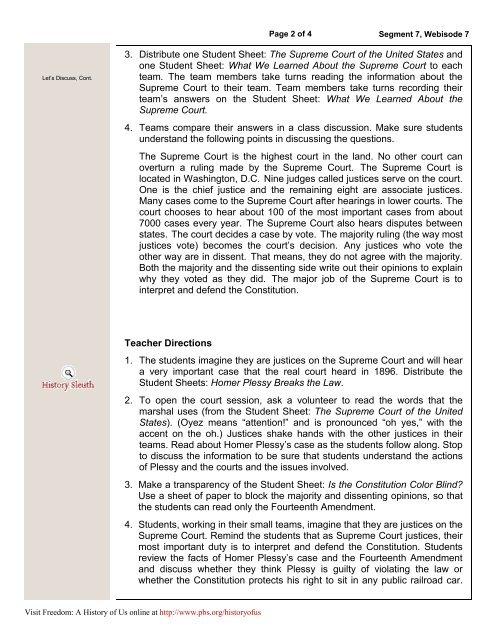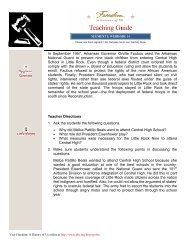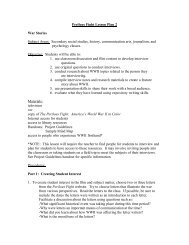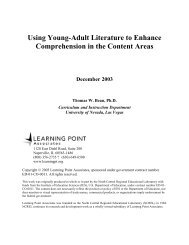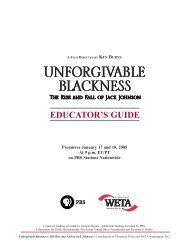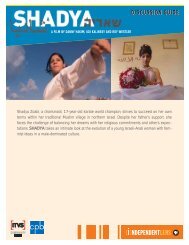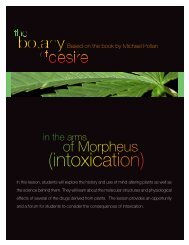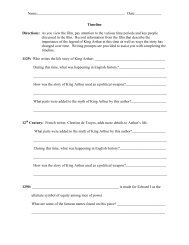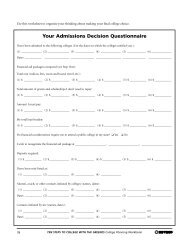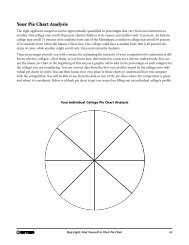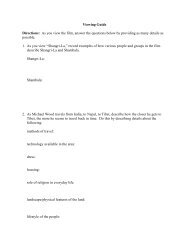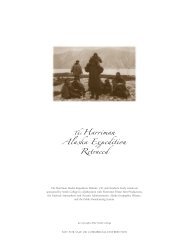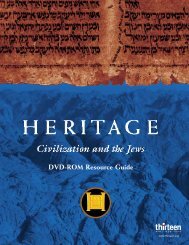Plessy v. Ferguson - PBS
Plessy v. Ferguson - PBS
Plessy v. Ferguson - PBS
You also want an ePaper? Increase the reach of your titles
YUMPU automatically turns print PDFs into web optimized ePapers that Google loves.
Page 2 of 4<br />
Segment 7, Webisode 7<br />
Let’s Discuss, Cont.<br />
3. Distribute one Student Sheet: The Supreme Court of the United States and<br />
one Student Sheet: What We Learned About the Supreme Court to each<br />
team. The team members take turns reading the information about the<br />
Supreme Court to their team. Team members take turns recording their<br />
team’s answers on the Student Sheet: What We Learned About the<br />
Supreme Court.<br />
4. Teams compare their answers in a class discussion. Make sure students<br />
understand the following points in discussing the questions.<br />
The Supreme Court is the highest court in the land. No other court can<br />
overturn a ruling made by the Supreme Court. The Supreme Court is<br />
located in Washington, D.C. Nine judges called justices serve on the court.<br />
One is the chief justice and the remaining eight are associate justices.<br />
Many cases come to the Supreme Court after hearings in lower courts. The<br />
court chooses to hear about 100 of the most important cases from about<br />
7000 cases every year. The Supreme Court also hears disputes between<br />
states. The court decides a case by vote. The majority ruling (the way most<br />
justices vote) becomes the court’s decision. Any justices who vote the<br />
other way are in dissent. That means, they do not agree with the majority.<br />
Both the majority and the dissenting side write out their opinions to explain<br />
why they voted as they did. The major job of the Supreme Court is to<br />
interpret and defend the Constitution.<br />
Teacher Directions<br />
1. The students imagine they are justices on the Supreme Court and will hear<br />
a very important case that the real court heard in 1896. Distribute the<br />
Student Sheets: Homer <strong>Plessy</strong> Breaks the Law.<br />
2. To open the court session, ask a volunteer to read the words that the<br />
marshal uses (from the Student Sheet: The Supreme Court of the United<br />
States). (Oyez means “attention!” and is pronounced “oh yes,” with the<br />
accent on the oh.) Justices shake hands with the other justices in their<br />
teams. Read about Homer <strong>Plessy</strong>’s case as the students follow along. Stop<br />
to discuss the information to be sure that students understand the actions<br />
of <strong>Plessy</strong> and the courts and the issues involved.<br />
3. Make a transparency of the Student Sheet: Is the Constitution Color Blind?<br />
Use a sheet of paper to block the majority and dissenting opinions, so that<br />
the students can read only the Fourteenth Amendment.<br />
4. Students, working in their small teams, imagine that they are justices on the<br />
Supreme Court. Remind the students that as Supreme Court justices, their<br />
most important duty is to interpret and defend the Constitution. Students<br />
review the facts of Homer <strong>Plessy</strong>’s case and the Fourteenth Amendment<br />
and discuss whether they think <strong>Plessy</strong> is guilty of violating the law or<br />
whether the Constitution protects his right to sit in any public railroad car.<br />
Visit Freedom: A History of Us online at http://www.pbs.org/historyofus


